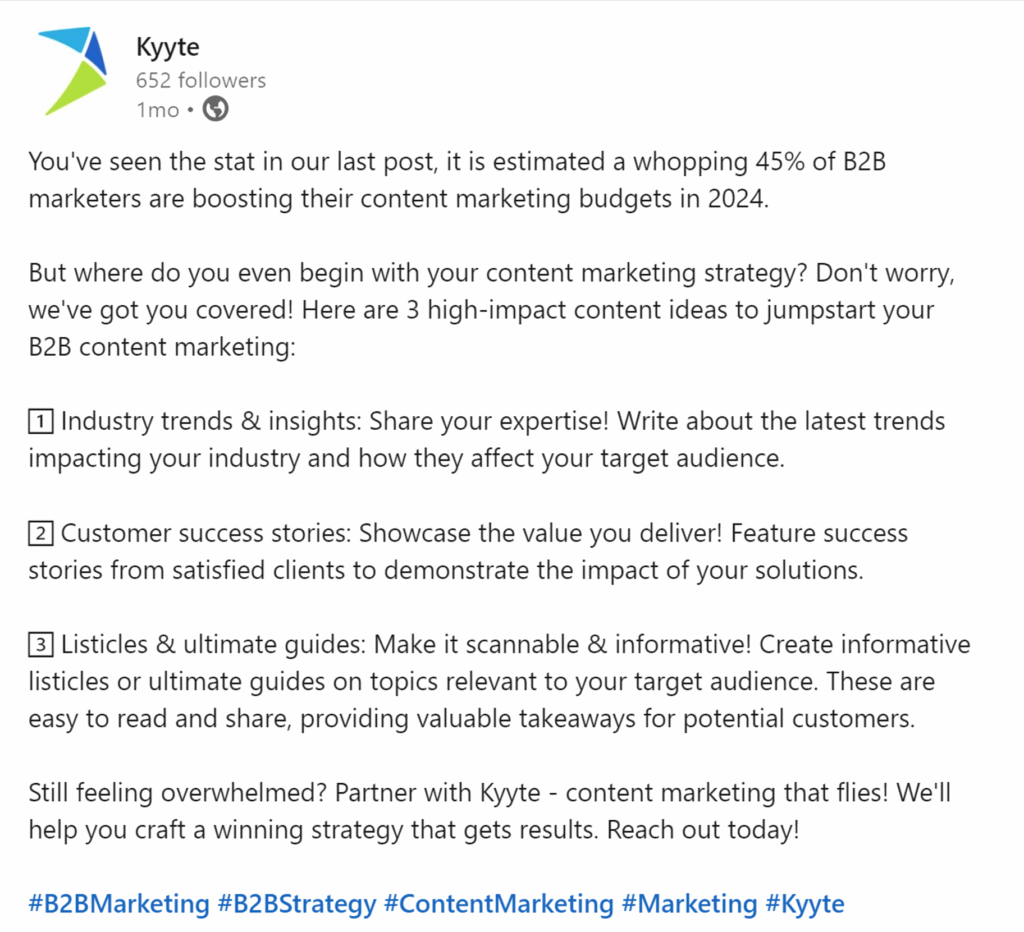First, let me share examples of repurposing from my childhood.
The art of repurposing is not new. As a kid, my Dad would keep empty Vegemite and peanut butter jars. When he had enough, he would clean and sterilise them, cook a big batch of pickles, and repurpose the jars to store his prize pickles.
Mum would do the same. If there were leftover vegetables from dinner the night before, Mum would make a classic bubble and squeak breakfast by adding eggs and toast, repurposing dinner into breakfast.
To be honest, when I was younger, I was never keen on Dad’s pickles, but as an adult, whenever he visits me now in Singapore, he packs a few jars of pickles for me to enjoy.
Time to dive into content repurposing for modern marketers.
Have you ever poured your heart and soul into copywriting the perfect blog post[1], only to see it go unnoticed with minimal engagement? Unfortunately, you’re not alone. Many businesses struggle to get the most out of their content. Here’s the good news: Just like my Mum and Dad do repurposing around the house, you too can breathe new life into your existing content and transform it into new content powerhouses that drive results.
A recent report by Semrush[2] shows that 42% of marketers and business owners say that updating and repurposing content leads to content marketing success.
This blog post is your guide to content marketing repurposing, a strategic approach that allows you to squeeze every drop of value from the existing content you produce. Let’s explore how to turn your existing blog posts into additional content marketing assets, including infographics, videos, and social media content while saving you time and resources.
Why repurpose your existing content?
The benefits of repurposing content are numerous. Here are just a few:
1. Increased reach and engagement:
Repurposing your content exposes and introduces it to new audiences across different platforms. By presenting information in various formats, you cater to people’s individual learning styles and capture the attention of a broader range of potential customers. Imagine a data-driven blog post transformed into a visually stunning infographic. It can attract new viewers who were not drawn to the original text format. People take in content differently, so produce content for your audience in different formats.
2. Improved SEO:
Repurposing your content by incorporating relevant keywords and creating internal links can significantly boost your website’s standing with search engines. This approach can lead to better rankings and more site visitors. For example, if you have a blog post titled ‘Common Marketing Mistakes,’ you could transform it into an engaging infographic that lives on your site. By using the exact important keywords and linking to related content on your website, this infographic makes the information more digestible and helps strengthen those keywords across your site. This approach can improve your site’s ranking in search results, drawing more relevant traffic.
3. Enhanced brand awareness:
Repurposing content across various channels keeps your brand top-of-mind with your target audience. You establish yourself as a thought leader in your industry by consistently delivering valuable information in different formats. Imagine your audience encountering your brand on social media with a captivating video snippet derived from a blog post they might have missed—it reinforces your brand message and expertise.
4. Save time and resources:
Repurposing leverages the time and effort already invested in content creation. You’re not starting from scratch; you’re simply adapting existing content to new formats. This frees up valuable resources for other marketing initiatives, allowing you to do more with less.
Identifying content gems for repurposing.

Not all content is created equal. So, how do you identify the blog posts with the potential to become your content repurposing gems? Here are some key indicators:
1. High-performing blog posts:
Look for blog posts with significant traffic, shares, and comments. This indicates valuable content that resonates with your audience. These posts are strong candidates for repurposing because they’ve already proven engaging.
2. Evergreen content:
Content with timeless information and relevant insights can be repurposed for extended periods. For example, a blog post on “content marketing best practices” might hold value for years, making it an excellent choice for repurposing into different formats.
3. Adaptability:
Content that lends itself well to visual representation (data-heavy content) or information that can be broken down into digestible chunks is ideal for repurposing into different formats. Content-rich in statistics and figures is perfect for transforming into infographics, while posts with clear steps or procedures can be repurposed into social media listicles.
It could even be a product blog post you wrote a while back, and your awesome product just got even better with some updates! So, what do you do? Well, you have two options: update the old blog post to reflect the new and improved features, or maybe even craft a brand new blog announcing the product’s relaunch. Updating old content is another important content marketing strategy. By shining a spotlight on the product’s recent improvements, you can reconnect with your audience and remind them the benefits of your product and why is great! Then, of course, it’s time to repurpose that information and spread the word across all your marketing channels.
Content repurposing strategies in action.
I find content transformation exciting. In the near future, I will turn many parts of this blog into Social media carousels and other digestible formats. I recently turned one blog into 22 pieces of content for LinkedIn! Below are three powerful repurposing strategies to bring your existing blog posts back to life:
1. Infographics: data visualisation powerhouse.
Imagine turning dry statistics from your blog post into a visually stunning infographic that grabs attention and simplifies complex information. Here’s how:
- Identify key data points and statistics from your blog post.
- Partner with a designer or use online infographic creation tools. User-friendly online tools can help you create infographics even without graphic design expertise.
- Create a visually appealing infographic using clear charts, icons, and captivating visuals to represent the information. Consider your target audience and tailor the design aesthetic to resonate with them.
- Include a call to action (CTA) directing viewers to the original blog post for a deeper dive. This CTA could be a simple button or text encouraging viewers to learn more.
2. Videos: Engaging storytelling at its finest.
Transform parts of your blog post into a video that brings your content to life. Here’s the recipe for video success:
- Adapt the blog post into a script for a short explainer video. Focus on the key takeaways and write a concise script that is easy to understand and follow.
- Use visuals, animation, or screencasts to enhance the content and keep viewers engaged. Visual elements can break up text-heavy content, making the video visually appealing.
- Promote the video on social media platforms like YouTube or LinkedIn, leveraging relevant keywords and hashtags for discoverability. Consider paid promotion options to reach a wider audience beyond your existing followers.
3. Social media posts: bite-sized content for snackable engagement.
Social media is a prime playground for repurposing content. Here’s how to turn your blog post into social media gold:
- Extract key takeaways, quotes, or interesting facts from the blog post. Break down your content into digestible pieces that are perfect for quick consumption on social media platforms.
- Create engaging social media posts (Twitter threads, Instagram posts) with eye-catching visuals that complement the text. Use relevant images, GIFs, or short videos to grab attention and make your posts stand out.
- Include a shortened link back to the original blog post for further reading. Shortened links like those provided by bit.ly [3] are ideal for social media as they don’t take up valuable character space.
Pro tips for content repurposing success.

To ensure your repurposing efforts return optimal results, consider these pro tips:
1. Maintain brand consistency across all repurposed content.
Use your brand fonts, colours, and overall visual identity to ensure all content is recognisable as coming from your brand.
2. Optimise each format for its specific platform.
For instance, keep video length short for social media (ideally under 2 minutes) and ensure infographic size is suitable for website display without compromising quality.
3. Use relevant hashtags and keywords to enhance discoverability.
Research popular hashtags and keywords related to your content to help people find your repurposed content on social media platforms and search engines.
4. Track the performance of your repurposed content.
Remember to adjust your strategies as needed. Use website analytics tools and social media insights to track how your repurposed content is performing. Analyse what’s working well and adapt your approach based on the data.
Case Study: Turning one blog post into 21 pieces of repurposed content.
We recently wrote a blog for our insights page: 10 Stats to Guide Your B2B Content Marketing Strategy.
We took our time copywriting this blog to ensure the relevance of current stats and the linking to the original reports/research from which the stats originated.
These days, there is so much generic AI content being created that it is hard to find the relevant reports or reference points for stats mentioned in blog content, so we were proud of our research, copywriting, and personal insights shared.
Below is the blog post:

Now, let the content repurposing begin.
From this blog, we have repurposed the content and created the following additional content:
- 1 x LinkedIn post – Introducing the blog
- 10 x LinkedIn posts – One post for each stat. The image is the stat itself, with the copy written to support it. Of course, we have a link to our original blog post on our website.
- 10 x LinkedIn posts – One thought leadership post, giving content ideas to support them that relate to the stat we shared.


Let’s not forget that these can be shared on other social networks, such as Instagram and Facebook.
Conclusion: Content repurposing – your secret weapon.
Repurposing your existing content isn’t about giving old blog posts a second chance. It’s about strategically maximising the value of your content investment. By following these tips and using your creativity, you can transform your existing blog posts into content powerhouses that drive traffic, engagement, and brand awareness. Remember, repurposing is an ongoing process. Regularly evaluate your content library and identify new opportunities to breathe fresh life into your existing content assets.
Content repurposing does not just relate to blog content either. I recently advised a company who was not even a client to turn their whitepaper (that was +7000 words of text – not designed) into bite-sized digestible content. They must have put so much effort into this whitepaper, and I would say, not many people have read it – really, really sad and a wasted opportunity in my eyes.
Call to action:
Ready to unlock your content’s hidden potential? Audit your blog posts today and identify candidates for repurposing! If you need help getting started, contact our content marketing experts at Kyyte – content marketing that flies! We can help you develop a comprehensive repurposing strategy that maximises your content’s impact today.
Content repurposing FAQs.
What is content repurposing?
Content repurposing is the strategic practice of taking existing content and transforming it into new formats. This allows you to maximise the value of your content library by reaching new audiences and refreshing older pieces that might be gathering dust online.
What is an example of repurposing?
Imagine a blog post packed with data and statistics. You could repurpose that content into a visually appealing infographic that simplifies complex information. Another option: turn a step-by-step blog post into a social media listicle with clear, actionable takeaways.
How do I repurpose content?
The first step is identifying high-performing or evergreen content in your library. Then, consider the format that best suits the information. Data-heavy content might become an infographic, while a listicle could be transformed into social media posts. There are also online tools to help create visuals without graphic design expertise. Remember to include a call to action directing viewers back to the original blog post for more details.
Can you repurpose other people’s content?
Generally, no. Repurposing content without permission could fall under copyright infringement. However, you can create original content inspired by others’ work. For instance, a blog post on “common marketing mistakes” could spark your own unique perspective on the same topic.
How often should I repurpose content?
There’s no one-size-fits-all answer, but a good rule of thumb is to revisit high-performing content every 6-12 months. See if there’s new information to add or if a fresh format could breathe new life into the piece and reach a wider audience.
References:
- Kyyte – How to Write B2B Content Marketing Blogs That Get Results
- Semrush 2023 State of Content Marketing Report
- URL Shortener https://bitly.com/
